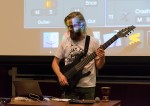Michael Andrews has taught math at UCLA for three years but is leaving this year to pursue his passion for art.
To celebrate his career change, Andrews, an assistant adjunct professor in the mathematics department, analyzed heavy metal and showed his own audiovisual art at a talk Thursday. About 200 people attended the talk, which was hosted by the Undergraduate Mathematics Student Association.
Andrews said he decided to transition out of teaching because he wanted to be able to use his math skills more creatively, such as coding audiovisual performances.
“To me, creativity is everything – I think maybe I could be in touch with my artsy side,” he said. “Academic pursuits are great, but they become inaccessible – enjoying music is easy.”
Andrews said he has always had a passion for music. He learned to play the drums when he was 10 years old and the guitar when he was 13.
“I wanted to be a rock star,” Andrews said.
As he grew up, however, he briefly let his love of math take over.
“I let one win,” Andrews said. “I loved math the most between (the ages of) 17 and 20. But music is my biggest love.”
For one part of his talk Thursday, Andrews displayed a screen that flashed lights and bounced balls, making clicking noises and soft “pong” sounds.
Despite the seemingly fluid and random quality of the videos, Andrews said he used high-order math and coding to create the performance on the screen.
Andrews said he hopes he can encourage students to be more in touch with their artistic side because he does not think traditional math classes allow students to express themselves.
“I would like mathematicians to be more open,” he said. “Math is very creative, but it’s not taught in a way that allows it to be.”
Andrews said one of his students at UCLA recently affirmed his decision to make the career switch. Although the student had struggled in Andrews’ calculus class, Andrews was mesmerized by how gifted of a dancer his student was when he saw him dance at the world arts and culture showcase last weekend.
“I want to empower artists,” Andrews said. “The only thing I can get behind as a human pursuit is creativity.”
Andrews added that transitioning from being a professor to an artist was not easy for him because pursuing math is the safer financial option.
“Lots of people don’t do what they want to do because they’re scared,” Andrews said.
Allison Lu, a fourth-year mathematics/economics student, said Andrews’ talk inspired her because her professors don’t normally encourage her to use math as a means of self-expression.
“There’s more to math than just theorems and proofs,” she said. “I was aware of that, but seeing it from an established professor was inspiring.”
William Baker, a mathematics graduate student, enjoyed the talk despite not having any musical background. He said he thinks Andrews made the music accessible by incorporating visual elements.
Baker said he liked that the audiovisuals in Andrews’ performance were not as structured as traditionally composed music with regular time signatures. In his performance, Andrews played songs by the Swedish metal band Meshuggah, which used seven, nine and even 11 beats per measure.
“The randomness makes it feel almost more human,” he said. “The connection between the dynamics and visuals … was both surprising and mesmerizing.”
Andrews said he thinks being an artist will make him happier and said he plans to code more audiovisual performances in the future.
“It still feels weird to say that I’m an artist,” he said. “I’m used to saying ‘I’m a mathematician.’ In reality, I can be both.”

This is great! I love the story and wish the professor the best! 🙂 The photo on the headline, however, is unfortunately terrible given this piece is in large part about a visual performance. C’mon daily Bruin. Newspapers should know better.